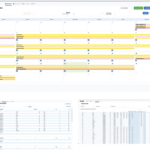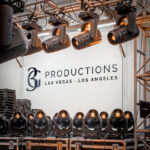“The company is new, but the product is not,” says Jocelyn Roux of Mega-Stage. Mobile stages, he adds, are “something that we know.” Roux is the head designer for the new-to-us stage company, which is based in Saint-Jean-sur-Richelieu, Québec, Canada, just southeast of Montreal.
The seemingly contradictory statement is easily explained. Sales manager Stephane Berger’s family had a history with another company known for their pioneering work with mobile stages (among other things). The Berger family, known as Groupe Berger, bought that company, and Stephane lured Roux, who had once worked for it, back into the fold.
For a new name, it’s an organization that is long in experience, both as a manufacturer of mobile stages and as users of them. For the past 30 plus years, they have been supplying sound, lighting, video and staging to clients in Canada, and their experiences doing so has had a major influence on their latest venture.
“We know how customers use mobile stages,” says Roux. “For instance, when you’re at a downtown park and you sometimes can’t move the stage too much one way or another. It gets wedged in somewhere, yet you still need full access to everything. We know because we’ve experienced that ourselves!”

The history of the company actually goes back to 1973. Fafard International was founded that year and their main purpose was the Herculean task of building airports. In 1982 the company built their first mobile stage, which Berger admits, “was not designed very well.” Later Berger’s father, Guy Berger, working with Fafard, would design and build a far superior electrical mobile stage prototype in 1994 that would be called the Logicstage.
By 1998 Fafard International was selling their mobile stages across Canada, U.S. and Europe, the latter being particularly challenging because of the strict European regulations imposed on such products. But the company succeeded in complying with them.
The Berger family would acquire the company in 2001, but the mobile stage side of the business was dormant for a while as the division was reorganized. Then it reemerged, harnessing the years of experience of Fafard’s operation with new direction and vision supplied by the Berger family. The company would be given a new name, too: Mega-Stage.

One of Berger’s first tasks was to attract design talent to the “new” company. He went directly to Roux, and in the words of an American movie cliché, made him an offer he couldn’t refuse. Roux had worked for Fafard in the 1990s, and he says he loved it. But when the organization stopped producing mobile stages, he moved onto other things. Now he’s back and he wouldn’t have it any other way.
“I love it when I’m involved in the design of a stage and it turns out really well. I can step back, look at it and say, ‘Wow,’” Roux says. “But when Stephane approached me about this company, I had another very good job — I was very grounded. ‘Why should I leave that?’ I thought. But then he explained his vision to me. At heart I’m a designer, and when I have the chance to work with someone who has a vision, I feel I can go to the moon. Too often people are closed minded, and there’s no room to create. But that’s not the way it is here. Stephane has a very open mind.”
First, they set out to redesign the Dynastage series of products. Roux was involved in the 1998 version, which he maintains was the very first aluminum stage, but the new version would need to make a bold impression. Today it’s their most compact line of mobile stages. The floor and roof are both hydraulically deployed and the leveling is handled with standard scaffolding screw jacks. They come with built-in pipes that allow for lights to be rigged, as well as audio, video, rigging motors and other equipment. It’s quick to set up, and it requires no external electricity to be deployed.

“It’s fully galvanized,” Roux says, adding with emphasis that the larger Groupe Berger is both a client and probably the best testing ground for all their mobile stages. “It was a pain for our people to paint a mobile stage every year, so we won’t ask our customers to do it, even if it means it costs a little more,” Berger adds. Both say that by using the prototypes and products in action and seeing them up close, they are able to refine them. They also welcome comments and criticism, as it allows the design team to improve the product.
“The Berger family rents sound, lights and video equipment, and a lot of people working inside the company are using our stages, so I get unlimited feedback even before it’s built,” Roux explains. “I will design something, do a 3-D model of it and show it those in the company who use them all the time. And they will say, ‘Yes it’s good, but…’ Then we are able to incorporate their comments into the final design, and before it’s fabricated it’s practically already tested.
“Everyone comes and whines to me, but if I didn’t listen to those guys, we’d be like the other companies!” he laughs.
Berger explains that as improvements were made to their initial mobile stages, the first big success was in achieving a better set-up time: it was cut in more than half. It’s now down to two people setting it up in 35 minutes sans tools.
They also have a Lightweight series that offers stages from 20 feet by 16 feet by 10 feet to 32 feet by 32 feet by 15 feet. The 24-foot-by-20-foot-by-15-foot stage is their most popular model. They feature vibration reduction in the floors and hinge covers, and sound and lighting necessities are built right in. The Pro series offers stages from 32 feet by 30 feet by 21feet up to 50 feet by 38 feet by 27. “The nice thing about the two series is they take the same training. If you use the Lightweight series, you know how to use the Pro Series” and vice-versa, Roux says.
“Often you’re asked by customers to make a 32 foot stage be as strong as a 40 foot stage,” he continues. “The Pro series addresses this. We have a platform that doesn’t need to double-up and it allows you to rig LED screens on the wing and in the back. Plus it has all these other components. They are excellent stages for big lighting and sound equipment. And the Pro series are the most reliable mobile stages on the market,” he says. “We’re about 25 percent cheaper yet offer 50 percent more rigging capacity.”
But Mega-Stage is not stopping at mobile stages. Berger says they are getting into the accessory market, designing riser systems and guardrails. He adds that he’s been showing their risers to the clients and they are all impressed with their light weight. With fuel prices at a premium, the savings arising from lower-weight products becomes more significant. Mega-Stage is especially sensitive to that and they work to create products accordingly.
Mega-Stage is also the exclusive U.S. distributor for ArcoFab, which manufacturers ground support and truss systems.
“This allows us to offer customers a complete range of products,” says Berger.
And that’s a very wise move, especially for such a “young” company.


